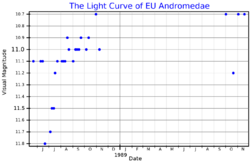EU Andromedae
Topic: Astronomy
 From HandWiki - Reading time: 3 min
From HandWiki - Reading time: 3 min
| Observation data Equinox J2000.0]] (ICRS) | |
|---|---|
| Constellation | Andromeda |
| Right ascension | 23h 19m 58.8815s[2] |
| Declination | +47° 14′ 34.576″[2] |
| Apparent magnitude (V) | 10.7 – 11.8 variable [3] |
| Characteristics | |
| Spectral type | C-J5− C25 j3.5[4] |
| Apparent magnitude (B) | 12.84[5] |
| Apparent magnitude (V) | 10.38[5] |
| Apparent magnitude (G) | 9.0005[2] |
| Apparent magnitude (J) | 5.526[6] |
| Apparent magnitude (H) | 4.492[6] |
| Apparent magnitude (K) | 4.018[6] |
| B−V color index | 2.5687[5] |
| Variable type | Lb?[3] |
| Astrometry | |
| Proper motion (μ) | RA: 2.062±0.080 [2] mas/yr Dec.: −3.263±0.072[2] mas/yr |
| Parallax (π) | 0.6515 ± 0.0561[2] mas |
| Distance | 5,000 ± 400 ly (1,500 ± 100 pc) |
| Details | |
| Radius | 82[2] R☉ |
| Luminosity | 983[2] L☉ |
| Temperature | 3,579[2] K |
| Other designations | |
| Database references | |
| SIMBAD | data |
EU Andromedae (often abbreviated to EU And) is a carbon star in the constellation Andromeda. Its apparent visual magnitude varies in an irregular manner between 10.7 and 11.8.[3]
Infrared observations of EU Andromedae show the presence of silicate grains, indicating the presence of an oxygen-rich circumstellar shell around the star, a combination known as a silicate star. Subsequently, a water maser was detected around this star (and for the first time around a carbon star), confirming the existence of the shell.[7] The most recent observations suggest that the maser originated in a circumstellar disc, seen nearly edge-on, around an unseen companion with a minimum mass of 0.5 M☉. Carbon dioxide has been detected for the first time in a silicate carbon star around EU Andromedae.[8][9]
EU Andromedae is given as the standard star for the C-J5− spectral class. C-J spectral types are assigned to stars with strong isotopic bands of carbon molecules, defined as the ratio of 12C to 13C being less than four. A more complete spectral type includes the abundance indices C25 j3.5, which indicate the Swan band strength and the isotopic band ratio.[4]
References
- ↑ "Download Data". AAVSO. https://www.aavso.org/data-download.
- ↑ 2.0 2.1 2.2 2.3 2.4 2.5 2.6 2.7 2.8 Brown, A. G. A. (August 2018). "Gaia Data Release 2: Summary of the contents and survey properties". Astronomy & Astrophysics 616: A1. doi:10.1051/0004-6361/201833051. Bibcode: 2018A&A...616A...1G. Gaia DR2 record for this source at VizieR.
- ↑ 3.0 3.1 3.2 EU And, database entry, Combined General Catalog of Variable Stars (GCVS4.2, 2004 Ed.), N. N. Samus, O. V. Durlevich, et al., CDS ID II/250 Accessed on line 2018-10-17.
- ↑ 4.0 4.1 Barnbaum, Cecilia; Stone, Remington P. S.; Keenan, Philip C. (1996). "A Moderate-Resolution Spectral Atlas of Carbon Stars: R, J, N, CH, and Barium Stars". The Astrophysical Journal Supplement Series 105: 419. doi:10.1086/192323. Bibcode: 1996ApJS..105..419B.
- ↑ 5.0 5.1 5.2 Høg, E.; Fabricius, C.; Makarov, V. V.; Urban, S.; Corbin, T.; Wycoff, G.; Bastian, U.; Schwekendiek, P. et al. (2000), "The Tycho-2 catalogue of the 2.5 million brightest stars", Astronomy & Astrophysics 355: L27–L30, Bibcode: 2000A&A...355L..27H.
- ↑ 6.0 6.1 6.2 Cutri, Roc M.; Skrutskie, Michael F.; Van Dyk, Schuyler D.; Beichman, Charles A.; Carpenter, John M.; Chester, Thomas; Cambresy, Laurent; Evans, Tracey E. et al. (2003). "VizieR Online Data Catalog: 2MASS All-Sky Catalog of Point Sources (Cutri+ 2003)". CDS/ADC Collection of Electronic Catalogues 2246: II/246. Bibcode: 2003yCat.2246....0C. http://vizier.u-strasbg.fr/viz-bin/VizieR?-source=II/246.
- ↑ Benson, P. J.; Little-Marenin, I. R. (1987). "A Water Maser Associated with EU Andromedae: A Carbon Star near an Oxygen-rich Circumstellar Shell". Astrophysical Journal Letters 316: L37. doi:10.1086/184887. Bibcode: 1987ApJ...316L..37B.
- ↑ Ohnaka, K.; Boboltz, D. A. (2008). "Imaging the oxygen-rich disk toward the silicate carbon star EU Andromedae". Astronomy and Astrophysics 478 (3): 809–814. doi:10.1051/0004-6361:20079030. Bibcode: 2008A&A...478..809O.
- ↑ Lloyd Evans, T. (1990). "Carbon stars with silicate dust shells - I. Carbon stars with enhanced 13C (J stars)". Monthly Notices of the Royal Astronomical Society 243: 336. Bibcode: 1990MNRAS.243..336L.
 |
 KSF
KSF
